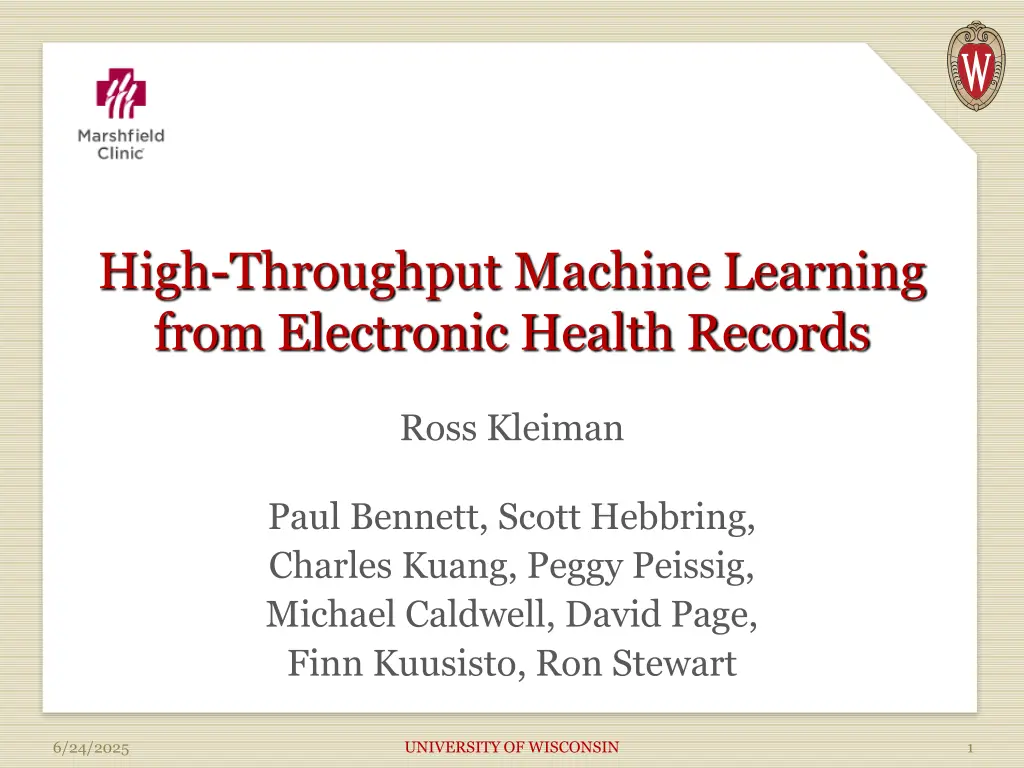
High-Throughput Machine Learning in Electronic Health Records Study
Explore a cutting-edge study on high-throughput machine learning from electronic health records at the University of Wisconsin, encompassing data cleaning, case-control definitions, dynamic definition refinement, and model construction and evaluation using a Random Forest Classifier.
Download Presentation

Please find below an Image/Link to download the presentation.
The content on the website is provided AS IS for your information and personal use only. It may not be sold, licensed, or shared on other websites without obtaining consent from the author. If you encounter any issues during the download, it is possible that the publisher has removed the file from their server.
You are allowed to download the files provided on this website for personal or commercial use, subject to the condition that they are used lawfully. All files are the property of their respective owners.
The content on the website is provided AS IS for your information and personal use only. It may not be sold, licensed, or shared on other websites without obtaining consent from the author.
E N D
Presentation Transcript
High-Throughput Machine Learning from Electronic Health Records Ross Kleiman Paul Bennett, Scott Hebbring, Charles Kuang, Peggy Peissig, Michael Caldwell, David Page, Finn Kuusisto, Ron Stewart UNIVERSITY OF WISCONSIN 1 6/24/2025
Marshfield Clinic EHR Marshfield Clinic Health system in North Central Wisconsin 1.5M Patient Records spanning 40 years Demographics Diagnoses (ICD-9) Labs Procedures Vitals UNIVERSITY OF WISCONSIN 2 6/24/2025
Predicting All Diagnoses Prior work: Individual disease models How well can we predict all diagnoses? Given: All EHR data Do: Learn model to predict each disease ICD-9 Code Build a high-throughput machine learning pipeline >100 Years of Computing! UNIVERSITY OF WISCONSIN 3 6/24/2025
Data Cleaning Originally 1.5M patients Remove Infrequent Patients 4 diagnoses and 2 encounters 1.1M patients remained (~73%) UNIVERSITY OF WISCONSIN 4 6/24/2025
Case and Control Definition Identify cases and controls for each ICD-9 code Rule-of-2 Case has 2 or more target codes DX1 Control has no target codes Minimum of 500 cases per ICD-9 code DX2 DXn UNIVERSITY OF WISCONSIN 5 6/24/2025
Case Control Matching Censor Case DX DX Present day Birth Chart data Control +++++ Birth Death Chart data UNIVERSITY OF WISCONSIN 6 6/24/2025
Dynamic Definition Refinement Some health states lead to complications E.g. diabetes or pregnancy DDR attempts to discover prerequisite diagnoses Code ? is a prerequisite diagnosis for code ? if DX1 DXi DX2 DXn At least 85% of case patients for code ? first received code ? DKj, DXk UNIVERSITY OF WISCONSIN 7 6/24/2025
Model Construction and Evaluation Model nearly every ICD-9 code At least 500 case-control pairs Exclude symptoms Build model: Random Forest Classifier Evaluation metric: AUC- ROC UNIVERSITY OF WISCONSIN 8 6/24/2025
HTCondor & Our Research Compute time ~47,500 Condor jobs ~18 hours per job ~400 concurrent jobs ~1 Century of compute time in 3 months Specialized security measures Healthcare data is sensitive Fully separate submit server with highly restricted user pool Data encrypted during transmission and on disk UNIVERSITY OF WISCONSIN 9 6/24/2025
Predictive Accuracy of Models UNIVERSITY OF WISCONSIN 10 6/24/2025
UNIVERSITY OF WISCONSIN 11 6/24/2025
UNIVERSITY OF WISCONSIN 12 6/24/2025
Simulated Prospective Study How well would these models perform in practice? Evaluate model accuracy on 10,000 test patients Training Data Activity Window Study Year 2015 2013 2014 UNIVERSITY OF WISCONSIN 13 6/24/2025
Simulated Prospective Study UNIVERSITY OF WISCONSIN 14 6/24/2025
Project Summary We created a flexible and modular machine learning pipeline for all EHR diagnoses Can predict across all ICD-9 codes with reasonable degree of accuracy This is an initial baseline for pan-diagnostic machine learning Models promise more than just predictive use UNIVERSITY OF WISCONSIN 15 6/24/2025
What Have Our Models Learned? Feature importances are a window into a model Top heart attack features Age/Gender Hypertension Atherosclerosis Interesting features COPD & Red cell distribution width Tertemiz, et.al 2016 discovery Can we automatically discover useful lab tests? UNIVERSITY OF WISCONSIN 16 6/24/2025
Results Embryonic Stem Cell - 2004 NANOG UTF1 CBX4 POU5F1 EZH1 SOX1 IRX4 FOXD3 MYF6 HOXB4 LMO2 SOX2 EOMES LMX1B LHX2 HOXD9 HOXD11 OTX1 HAND1 HOXB3 Cardiomyocyte - 2008 MESP1 THRAP1 TBX20 GATA4 NKX2-5 TBX5 GATA5 MEF2C HAND2 CSRP3 IRX4 HDAC9 NFATC4 IRX5 MKL2 ISL1 GATA6 HAND1 HES2 TBX18 Hepatocyte - 2009 HNF1A HNF1B HNF4A ONECUT1 HNF4G FOXA3 ONECUT3 FOXA1 FOXA2 TCF2 MLX NR0B2 NR1I3 NR1H4 HGBOX1 NR1I2 ONECUT2 TCF1 CREB3L3 CUTL2
Lab Test Repurposing Goal: Discover novel diagnostic uses for currently available lab tests Ongoing work with Dr. Finn Kuusisto and Dr. Ron Stewart Candidate for lab repurposing Useful for predicting a diagnosis Not well known in literature KinderMiner to build the knowledge base on Condor Combine with feature importance values to find candidate labs UNIVERSITY OF WISCONSIN 19 6/24/2025
Acknowledgements Page Lab CHTC Dr. David Page, Ph.D. Dr. Miron Livny, Ph.D. Paul Bennett Lauren Michael Charles Kuang Marshfield Clinic Christina Koch Todd Tannenbaum Dr. Michael Caldwell, M.D. Zach Miller Funding Dr. Peggy Peissig, Ph.D. Dr. Scott Hebbring, Ph.D. Thompson Lab NLM Biomedical Training Grant 5T15LM007359 NIH BD2K Grant U54 AI117924 Dr. Finn Kuusisto, Ph.D. Dr. Ron Stewart, Ph.D. NLM Grant R01LM011028 UNIVERSITY OF WISCONSIN 20 6/24/2025
Questions? UNIVERSITY OF WISCONSIN 21 6/24/2025
